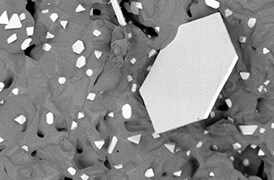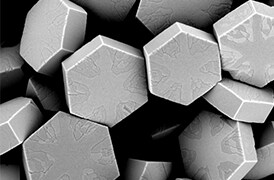Search Thermo Fisher Scientific

Materials Science
Cathodoluminescence Imaging
Cathodoluminescence analysis in electron microscopes for materials characterization.
Join the conversation
Cathodoluminescence
Cathodoluminescence (CL) is the process by which a material emits characteristic photons of visible light when struck by electrons (such as those produced by the source in an electron microscope). Researchers in geology, optoelectronics, failure analysis, ceramics, glass and many other fields use CL detection as a unique way to highlight sample properties that are not visible with conventional electron or X-ray imaging techniques. By correlating CL data to topography, crystallography and elemental information, a better understanding of photonic properties, composition, material quality or sample history can be obtained.
CL detector
A range of third-party CL accessories exists for the Thermo Scientific SEM and DualBeam product lines. These are usually specialized in spectral CL detection, i.e. the collection of a full spectrum for each pixel of the image (also called hyperspectral imaging). While this provides a great deal of information, most CL solutions suffer from alignment and ease-of-use issues, limitations in working distance and field of view, and/or cannot perform simultaneous detection of X-ray/backscattered electron signal.
The Thermo Scientific RGB Cathodoluminescence Detector offers real-color CL imaging, without any of the beforementioned limitations, integrated into the instrument user interface. It features a flat design that slides between the sample and the final lens, much like a retractable backscatter detector. Unlike conventional mirror-based solutions, the large detector area eliminates the need for any optical alignment and does not limit the field of view. Additionally, simultaneous detection of secondary electrons (SE), backscatter electrons (BSE) or X-rays is possible, enabling correlation of CL data with SE, BSE and energy-dispersive x-ray spectroscopy (EDS) in only a single scan of the electron beam.
Integrated into the user interface of the microscope, the RGB Cathodoluminescence Detector makes color images available as soon as the beam is scanning. This makes the detector a unique asset to multi-user labs requiring CL data and correlation with worry-free operation.
Documents
Documents

Quality control and failure analysis
Quality control and assurance are essential in modern industry. We offer a range of EM and spectroscopy tools for multi-scale and multi-modal analysis of defects, allowing you to make reliable and informed decisions for process control and improvement.

Fundamental Materials Research
Novel materials are investigated at increasingly smaller scales for maximum control of their physical and chemical properties. Electron microscopy provides researchers with key insight into a wide variety of material characteristics at the micro- to nano-scale.

Geological Research
Geoscience relies on consistent and accurate multi-scale observation of features within rock samples. SEM-EDS, combined with automation software, enables direct, large-scale analysis of texture and mineral composition for petrology and mineralogy research.

Oil and Gas
As the demand for oil and gas continues, there is an ongoing need for efficient and effective extraction of hydrocarbons. Thermo Fisher Scientific offers a range of microscopy and spectroscopy solutions for a variety of petroleum science applications.

Automotive Materials Testing
Every component in a modern vehicle is designed for safety, efficiency, and performance. Detailed characterization of automotive materials with electron microscopy and spectroscopy informs critical process decisions, product improvements, and new materials.
Electron microscopy services for
the materials science
To ensure optimal system performance, we provide you access to a world-class network of field service experts, technical support, and certified spare parts.












